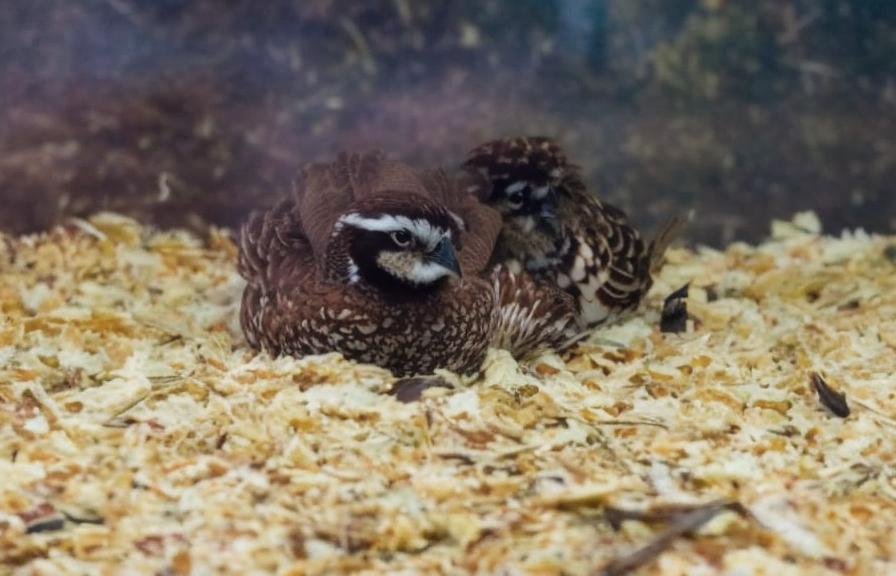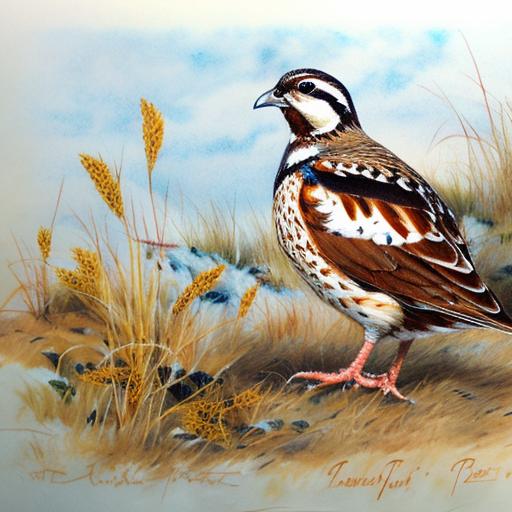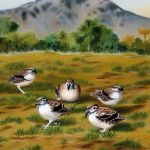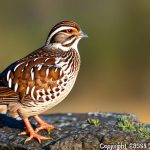Bobwhite quail breeding is a fascinating and rewarding endeavor for those interested in aviculture. The Northern Bobwhite, also known as the Virginia quail, is a popular game bird native to the United States, Mexico, and the Caribbean. These birds are known for their distinctive call that sounds like “bob-white,” which is where they get their name. Bobwhite quail are highly valued for their delicious meat and are also popular for hunting and as pets. Breeding bobwhite quail can be a fulfilling hobby or a profitable business venture for those with a passion for these beautiful birds.
Breeding bobwhite quail requires careful planning, attention to detail, and a deep understanding of the birds’ behavior and needs. From setting up a breeding colony to caring for the birds and harvesting their eggs and chicks, there are many aspects to consider when embarking on a bobwhite quail breeding project. In this article, we will explore the ins and outs of bobwhite quail breeding, including setting up a breeding colony, breeding and reproduction, feeding and care, health and disease management, and harvesting and utilizing eggs and chicks. Whether you are a novice breeder or an experienced aviculturist, there is always something new to learn about the fascinating world of bobwhite quail breeding.
Key Takeaways
- Bobwhite quail breeding is a rewarding and profitable venture for many farmers and hobbyists.
- Setting up a breeding colony for bobwhite quail requires careful consideration of space, housing, and environmental factors.
- Understanding the breeding and reproduction behaviors of bobwhite quail is essential for successful breeding and chick rearing.
- Proper feeding and care of bobwhite quail in a breeding colony is crucial for their health and productivity.
- Health and disease management are important aspects of maintaining a successful bobwhite quail breeding colony.
Setting Up a Breeding Colony for Bobwhite Quail
Setting up a breeding colony for bobwhite quail is the first step in embarking on a successful breeding program. The size of the breeding colony will depend on the scale of your operation and your breeding goals. A small-scale breeder may start with just a few pairs of quail, while a commercial breeder may have dozens or even hundreds of birds in their breeding colony. It is important to provide adequate space for the birds to move around and exhibit natural behaviors, as overcrowding can lead to stress and aggression among the quail.
The housing for the breeding colony should be secure, predator-proof, and well-ventilated. Quail are ground-dwelling birds that prefer to nest and roost on the ground, so the housing should include plenty of floor space with suitable nesting areas. The flooring should be covered with a soft bedding material such as straw or wood shavings to provide a comfortable environment for the birds. Additionally, the housing should be equipped with feeders and waterers that are easily accessible to the quail. Providing a suitable environment for the birds is crucial for their health and well-being, as well as for successful breeding and reproduction.
Breeding and Reproduction of Bobwhite Quail
Breeding and reproduction are natural behaviors for bobwhite quail, but there are several factors to consider to ensure successful breeding in a captive environment. The breeding season for bobwhite quail typically begins in the spring and continues through the summer months. During this time, male quail will exhibit courtship behavior such as strutting, calling, and displaying their plumage to attract females. It is important to provide a suitable environment for the birds that mimics their natural habitat, including plenty of vegetation and hiding spots for nesting.
Once the male has successfully courted a female, she will lay a clutch of eggs in a hidden nest on the ground. The female will typically lay one egg per day until she has laid a full clutch, which can range from 12 to 20 eggs depending on the breed and age of the bird. It is important to provide the female with a quiet and secure nesting area to minimize stress and disturbances during the egg-laying process. After the eggs are laid, they will need to be incubated for approximately 23-24 days before hatching. During this time, it is crucial to monitor the temperature and humidity levels in the incubator to ensure optimal conditions for embryo development.
Feeding and Care of Bobwhite Quail in a Breeding Colony
Feeding and care are essential aspects of maintaining a healthy and productive bobwhite quail breeding colony. A well-balanced diet is crucial for the overall health and reproductive success of the birds. Bobwhite quail are omnivorous birds that require a diet high in protein, especially during the breeding season. Commercially available game bird feed is an excellent option for providing the necessary nutrients for breeding quail. Additionally, offering supplemental sources of protein such as mealworms or crickets can help support the birds’ reproductive health.
In addition to a nutritious diet, providing clean water is essential for the well-being of the birds. Water should be readily available at all times, especially during hot weather when quail are more prone to dehydration. It is important to regularly clean and refill waterers to prevent contamination and ensure that the birds have access to clean water. Regularly monitoring the health and behavior of the birds is also crucial for early detection of any issues that may arise. Providing proper care, including regular health checks and prompt treatment of any illnesses or injuries, is essential for maintaining a thriving bobwhite quail breeding colony.
Health and Disease Management in a Bobwhite Quail Breeding Colony
Maintaining the health of a bobwhite quail breeding colony is paramount for successful breeding and reproduction. Preventative measures such as biosecurity protocols, regular cleaning and disinfection of housing and equipment, and monitoring for signs of illness are essential for disease management. Common health issues in bobwhite quail include respiratory infections, parasites, and nutritional deficiencies. It is important to work with a veterinarian experienced in avian medicine to develop a comprehensive health management plan for the breeding colony.
In addition to preventative measures, it is important to have a plan in place for addressing any health issues that may arise. This may include quarantine procedures for sick or injured birds, as well as treatment protocols for common illnesses. Regular health checks and observation of the birds’ behavior can help identify any potential health concerns early on. Providing a clean and stress-free environment, along with proper nutrition and care, can help minimize the risk of disease in a bobwhite quail breeding colony.
Harvesting and Utilizing Bobwhite Quail Eggs and Chicks

Harvesting bobwhite quail eggs and chicks is an exciting part of the breeding process that requires careful timing and attention to detail. Once the eggs have hatched, it is important to provide proper care for the chicks to ensure their health and well-being. This includes providing a warm brooding area with access to food and water, as well as protection from predators and other potential hazards. As the chicks grow, they will need to be transitioned to an appropriate housing setup that allows them space to move around while still providing protection from predators.
In addition to raising chicks, harvesting eggs from the breeding colony can provide an additional source of income or new breeding stock for future generations. Collecting eggs daily and storing them properly can help maximize their viability for hatching. Proper storage conditions include maintaining consistent temperature and humidity levels until the eggs are ready to be placed in an incubator. Careful handling of eggs during collection and storage is crucial for ensuring successful hatching rates.
Conclusion and Considerations for Bobwhite Quail Breeding
In conclusion, bobwhite quail breeding is a rewarding endeavor that requires careful planning, attention to detail, and a deep understanding of the birds’ behavior and needs. Setting up a breeding colony with suitable housing, providing proper nutrition and care, managing health and disease, and harvesting eggs and chicks are all essential aspects of successful bobwhite quail breeding. Whether you are interested in raising quail as pets, for hunting purposes, or as a commercial venture, there are many considerations to take into account when embarking on a bobwhite quail breeding project.
It is important to continually educate yourself on best practices for aviculture and seek guidance from experienced breeders or avian veterinarians when needed. By providing a suitable environment for the birds, maintaining their health and well-being, and carefully managing the breeding process, you can enjoy the many rewards of bobwhite quail breeding. Whether you are just starting out or have years of experience in aviculture, there is always something new to learn about these fascinating birds and their unique breeding behaviors. With dedication and passion, bobwhite quail breeding can be an enriching experience that offers countless opportunities for learning and growth within the avicultural community.
If you’re considering raising bobwhite quail in a breeding colony, you may also be interested in learning about the importance of providing a secure and comfortable environment for your poultry. Check out this article on the benefits of using a SnapLock chicken coop to ensure the safety and well-being of your birds. Creating a suitable living space is essential for the health and productivity of your quail, just as it is for other poultry species.
FAQs
What is a breeding colony of bobwhite quail?
A breeding colony of bobwhite quail refers to a group of quail that are kept together for the purpose of breeding and producing offspring. This can be done in a controlled environment such as a breeding pen or aviary.
Can bobwhite quail be raised in a breeding colony?
Yes, bobwhite quail can be raised in a breeding colony. This method allows for controlled breeding and the production of offspring for various purposes such as hunting, conservation, or research.
What are the benefits of raising bobwhite quail in a breeding colony?
Raising bobwhite quail in a breeding colony allows for better control over breeding pairs, genetic diversity, and the overall health and well-being of the quail. It also provides a more controlled environment for monitoring and managing the breeding process.
What are some considerations for raising bobwhite quail in a breeding colony?
Considerations for raising bobwhite quail in a breeding colony include providing adequate space, proper nutrition, and suitable nesting and breeding areas. It is also important to monitor the health of the quail and manage the breeding pairs to avoid inbreeding and maintain genetic diversity.
Are there any legal considerations for raising bobwhite quail in a breeding colony?
Yes, there may be legal considerations for raising bobwhite quail in a breeding colony, such as obtaining the necessary permits or licenses for breeding and keeping quail. It is important to research and comply with local and state regulations regarding the breeding and keeping of quail.
Meet Walter, the feathered-friend fanatic of Florida! Nestled in the sunshine state, Walter struts through life with his feathered companions, clucking his way to happiness. With a coop that’s fancier than a five-star hotel, he’s the Don Juan of the chicken world. When he’s not teaching his hens to do the cha-cha, you’ll find him in a heated debate with his prized rooster, Sir Clucks-a-Lot. Walter’s poultry passion is no yolk; he’s the sunny-side-up guy you never knew you needed in your flock of friends!







